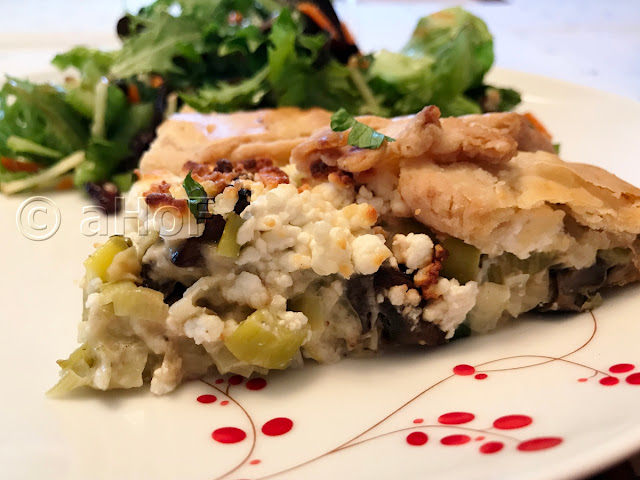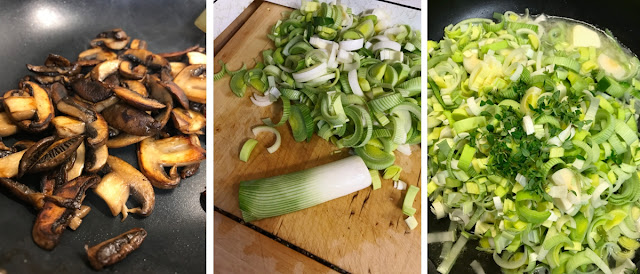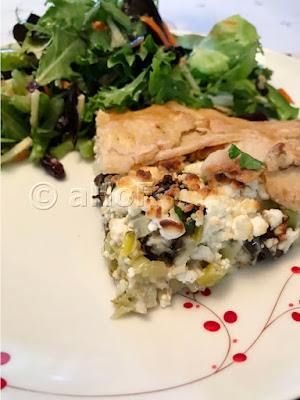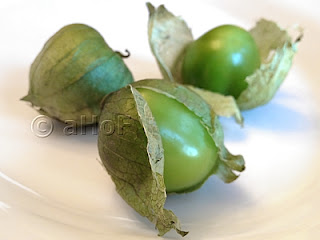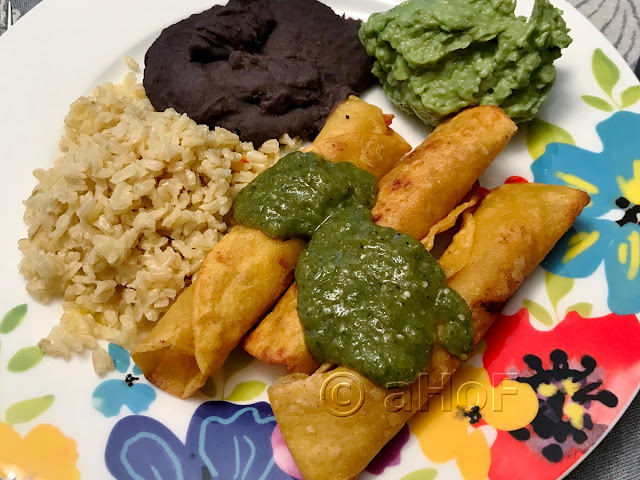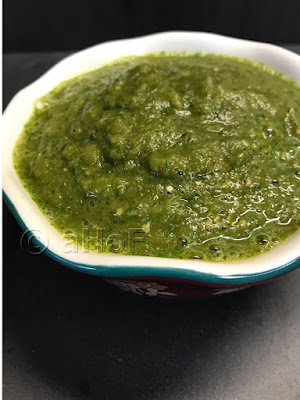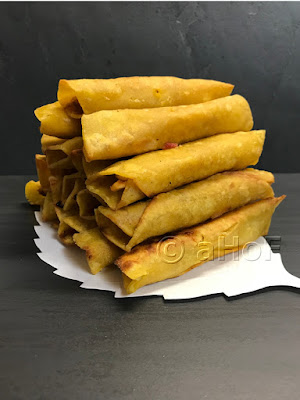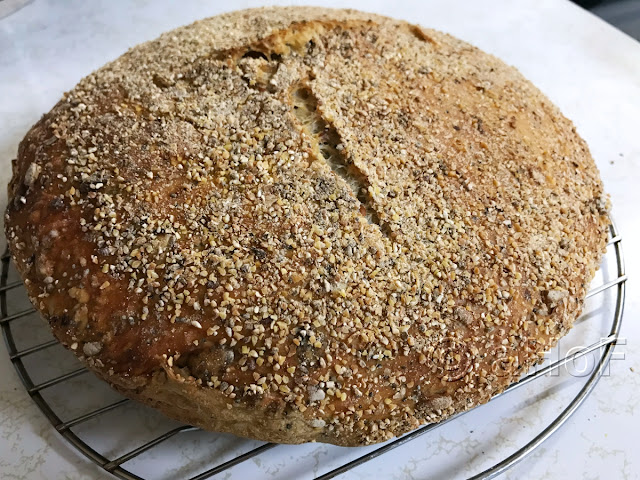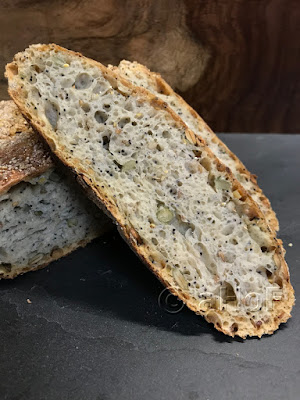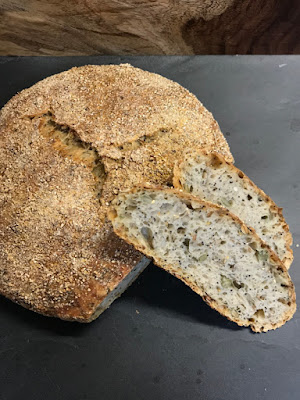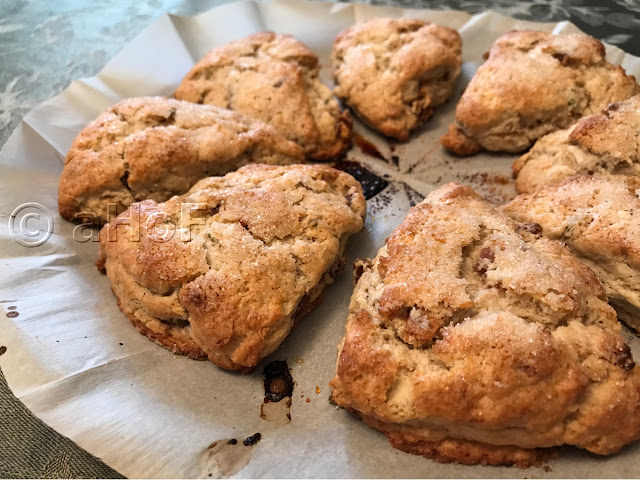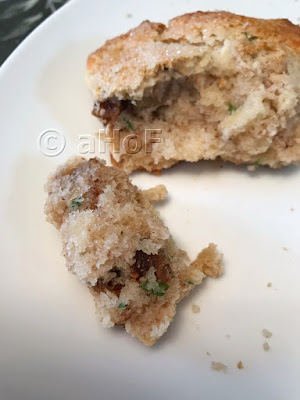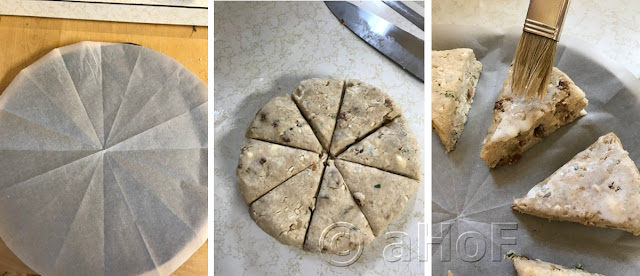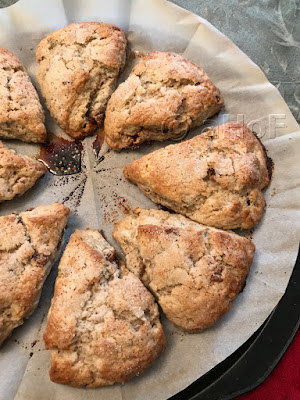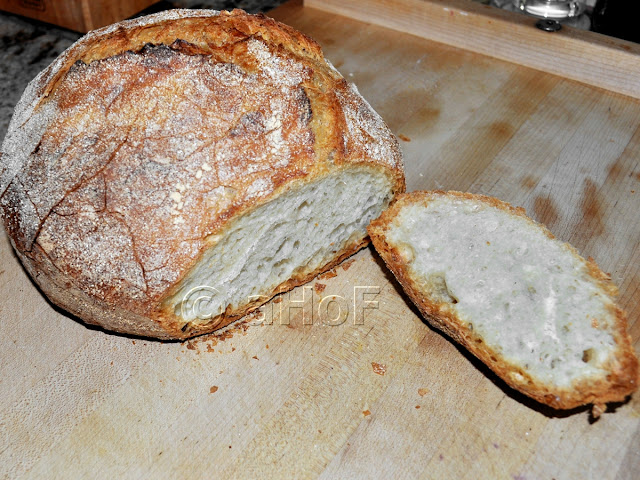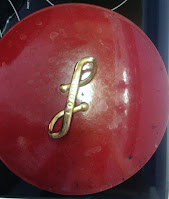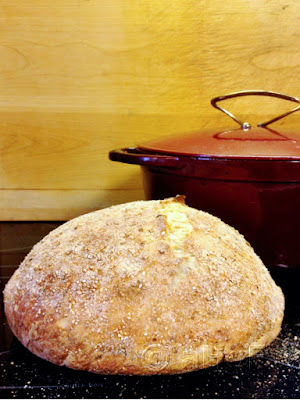Long, long ago, I made a recipe for the filling for Stuffed Peppers, and have been using that recipe ever since. I make them at least once a year, because we love them, and they are a tried and true recipe. While there is nothing inherently wrong with the recipe as it stands, I chose to make them one day recently but did not consult my old recipe at all.
Over these many years since I started making Stuffed Peppers, I have become more conscious of what I am using in a recipe, and more recently still, I have tried to lessen, if not eliminate ketchup. You see, my husband has a true ketchup addiction. Since I have known him, it is a rare meal where most everything is not literally covered in ketchup. When we would order fast food (only on road trips to somewhere), he would get at minimum 15 to 20 packets of ketchup to use on both burger and fries. It was not uncommon for him to use at least a half cup worth per meal. That is excessive, in my book.
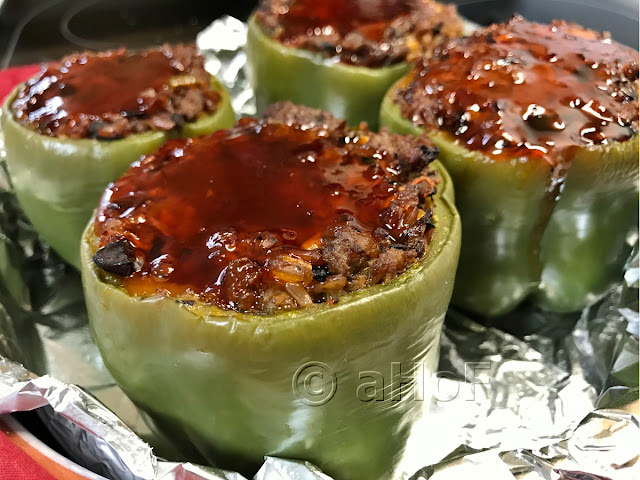 |
| Stuffed Bell Peppers |
So last year when he had some serious health issues centering on digestion, I offered to cook healthy foods, if he was willing to eat them, and forego ketchup on every single food. He has done excellently. Only recently, more than a year later, has he crept back, now and again, mostly while we are traveling, to using it at all. At home, no. So, with all that in mind, I hate like anything to re-introduce too much ketchup into his daily regimen, for fear that the "taste" for it will return. I have revised so many recipes, using tomato sauce, sometimes adding a little stevia for sweetness, vinegar for tartness. I knew that my recipe for Stuffed Peppers called for ketchup, but couldn't recall how much. So, when I started assembling things for the recipe, I did not consult my old recipe at all. It was interesting to see that I went for the same general flavors, but in differing amounts. This time, I used more rice, but a whole grain red rice, and less ketchup. There are a couple of other differences. Altogether, these were excellent, and not so different in flavor.
Stuffed Bell Peppers
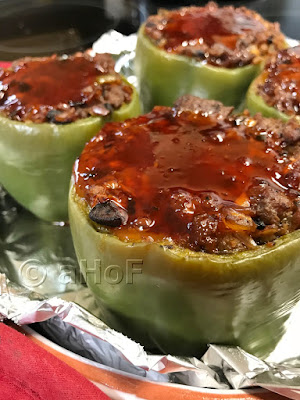 |
| Stuffed Bell Peppers |
Makes 4
2 cups cooked brown or red rice (about ¾ cup dry)
8 ounces Portobello Mushrooms, chopped finely
1 tablespoon olive oil, more if needed
½ teaspoon salt
1 pound lean ground beef
1 medium onion, chopped
2 - 4 cloves fresh garlic, minced
⅔ cup finely shredded carrot
⅔ cup finely chopped celery
⅔ cup minced green pepper (use pepper tops)
½ teaspoon dried thyme leaves
¾ teaspoon salt
1 tablespoon Worcestershire Sauce
½ cup ketchup
4 bell peppers
Sweet Sour Sauce, such as LaChoy's
Cook the rice ahead of time. Brown rice or red rice generally follows similar rules of thumb for cooking: twice the volume of water to rice and about 50 minutes to cook. Add in ¾ teaspoon salt while cooking. Once cooked through, if there is remaining water, drain it off and let the rice cool.
Heat a large skillet and add in the oil. Add the chopped mushrooms and the ½ teaspoon salt and cook, stirring occasionally, until the mushrooms are definitely browned. Turn out to a plate and set aside.
While the mushrooms are cooking, work with the peppers. Select peppers that have four lumps at the bottom, so they will stand up on their own. Cut off the tops of the bell peppers and separate any usable bits of the bell pepper from the tops and chop. Discard stems. Remove any membranes and seeds inside the pepper cups. Heat a large saucepan of water to boil and place the pepper cups in the water to cook, just until they start going an olive color, then remove quickly. Set them into a casserole.
Add in the hamburger meat to the skillet, with more oil only if needed, and cook, breaking apart to very small bits. Add in the onion and garlic and cook until they are softened. Add in the chopped bell pepper bits from the tops, with the carrot and celery, thyme and ¾ teaspoon salt. Add the Worcestershire, ketchup, rice and mushrooms and stir well. Pack this mixture very tightly into the bell pepper cups.
Preheat oven to 350 degrees. Top the pepper filling with 1 - 2 tablespoons of Sweet Sour Sauce and bake them for about 30 to 40 minutes, until well heated through.
~~~~~~~~~~~~~~~~~~~~~~~~
On to the Bread!
 |
| Five Seed Malted Bread |
A little over a week ago, I finally got a Five-Seed No-Knead Bread perfected. I was so pleased, since it took me four separate tries to get it just right.
Similarly, I have been making seeded loaves of bread from Paul Hollywood's cookbooks (bought after watching the Great British Baking Show). They have all turned out nicely and taste absolutely wonderful. So I went on to try some revisions and make a loaf of my own. Well, while the bread came out absolutely beautiful, it was dense and very hard. Dense is okay, up to a point. Though I love chewy bread, this was a bit over the top, and hard to chew! So, back to the drawing board with that one, also. But then I got thinking. In truth, I had already changed the recipe I was basing my bread on. Since Paul's recipe calls for "granary flour," and that is not locally available, I had created my own mixture to approximate granary flour or malt flour, based solely on his description of:
". . . a nutty taste and . . . slightly darker in colour. It is essentially a white flour with added flakes of malted wheat."
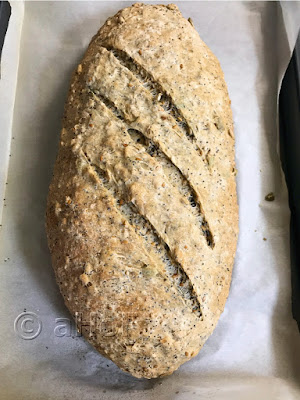 |
| Five Seed Malted Bread |
In approximating this flour, I used bread flour, plus a smaller amount of whole grain flour and an even smaller amount of lighter colored malted grain. Found whole anywhere there are beer-making supplies, or already ground in such places as King Arthur Flour site, this malted grain is called diastatic malt, and helps (in bread making) to give a boost to rising and also giving color to the baking loaf, if used in small amounts. To be safe, I also added a small amount of gluten for added structure.
Aside from this change to the recipe, while I really loved the beautiful way he created a sticky paste of soaked flax and sesame seeds to coat the outside of the bread, it was an added step that (IMHO) didn't help, particularly while toasting, as the whole coating would tend to lift off. Instead, I added the sesame seeds with the rest of the seeds into the loaf. And that is another change. While Paul's' loaf called for adding all those seeds into the loaf AFTER the first rise, it was nearly impossible to incorporate them without re-kneading the loaf. I chose to add them in at the end of the original kneading process. I added just a bit more water to the recipe, to accommodate a longer period with the thirsty seeds in contact with the dough. It made kneading a little more challenging. Probably would have been easier in the stand mixer, but I had chosen to knead by hand.
Ultimately, this time I am extremely happy with the outcome of my bread. It may not be as pretty without that coating, but it is dense with seeds, though not hard. It tastes wonderful, and all those seeds (a whole lot more than what went into the Five-Seed No-Knead Bread!) are beautifully incorporated.
You will need a kitchen scale for this recipe. I did measure out the seed quantities in cup measures, but the flour is easier to weigh out in grams.
Five Seed Malted Bread
Makes one loaf
 |
| Five Seed Malted Bread |
335 grams bread flour 135 grams whole wheat flour
15 grams diastatic malt powder
13 grams (2 tablespoons) gluten
5 grams instant yeast
10 grams fine salt
40 grams lard
350 milliliters (1½ cups) water, plus or minus 2 tablespoons as needed
SEED MIX:
70 grams (½ cup) raw pumpkin seed kernels
70 grams (½ cup) raw sunflower kernels
50 grams (⅓ cup) sesame seeds
50 grams (⅓ cup) flax seeds
50 grams (⅓ cup) poppy seeds
Combine the seeds together in a bowl and stir to distribute evenly. Set aside.
In a large bowl, or bowl of a heavy duty stand mixer with dough hook, place the first 4 ingredients and stir briefly. Add the yeast to one side and the salt to the other side, and add in the (slightly softened) lard. Pour in most of the water and mix until all ingredients are well moistened. If this does not happen, add in a bit of the remaining water until you have a soft dough. Grease a clean surface and turn the bread out to knead by hand for 8 to 10 minutes. If kneading in the mixer, knead for 6 to 8 minutes. At the end of the kneading time, add in the seeds all at once and continue to knead until incorporated evenly. Place the dough into a greased bowl, turning once so that a greased surface is on top and cover with plastic wrap. Set the bowl in a 70 - 75 degree area and allow to rise until doubled, 1 - 3 hours. Temperature is better on the cool side, as it allows for development of more flavor, but will take longer.
Once risen, where a light finger press will puff right back up easily, turn out again to a clean, oiled surface. Flatten slightly into an approximate square and roll the dough tightly, tucking in the ends as needed, to make a nice tight loaf. Set the loaf, seam side down, onto a parchment lined baking sheet. Coat the loaf with a fine sheen of oil and cover with the plastic film. Set to rise again until doubled in size.
Set one oven rack at second to bottom shelf and one rack in the topmost position. Set a wide, oven safe pan (fry pan or cake pan) on the top rack. Preheat oven to 400 degrees. Have one cup of boiling water at hand. Slash the top of the loaf three times diagonally, using a very sharp knife or bakers lame. Place the baking sheet with the bread in the lower oven rack, then carefully pour the boiling water into the pan on the top shelf. Time the loaf for 15 minutes. Reduce the oven temperature to 375 degrees and bake for another 25 to 35 minutes, or until the internal temperature is at least 200 degrees F. Remove from oven to a rack to cool completely before slicing.
~~~~~~~~~~~~~~~~~
Revisions as of February 2020:
I love this bread. Truly, it is one of the best, ever. But.
I often had a hard time getting it to truly rise. We live in a hot climate now, so there should be no excuse; at least I cannot blame the temperature. I wondered about the seeds. Are they possibly cutting gluten strands and making it more difficult to rise?
Then one evening I was watching some short YouTube shows on making bread, and one of the many I watched was making a bread with seeds in it. Instead of leaving them all whole, he pureed half the seeds to be used along with the full amount of water the recipe called for. This liquid was added to the dry ingredients and his bread rose beautifully. I opted to try this out. I have now been mixing up all the seeds called for in the recipe, then pouring half of them in the blender along with most of the water called for. The resultant slurry goes into the dry ingredients and I proceed to the kneading. The remaining seeds are still kneaded in for the last two minutes of kneading - - - which is another thing . . .
Kneading and the "Windowpane Test"
Recipes often say to knead until the dough passes the windowpane test, "about 10 minutes," or "around 12 minutes." And whether the dough passed the windowpane test or not (usually not, particularly with dense, whole grain breads), I would proceed with the recipe. And usually, the bread would not rise properly and would instead bake to a nice, flat, loaf.
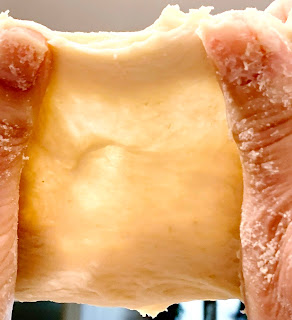 |
| The Windowpane Test |
"What is the "windowpane test?" you might ask. The "windowpane happens when the dough has been kneaded sufficiently for the gluten strands to fully develop. To check for this windowpane, pull off a small amount of dough and begin stretching it between both hands. The dough should hold, without tearing, to stretch to a thin area about 3 to 4 inches square, thin enough to be able to see light through it. With white breads, this is easily accomplished in the generally stated 10 to 12 minutes. With heavy, whole grain breads, or with this bread with a lot of heavy seeds to support, it can take longer. A lot longer in some cases.
So, about the time when I started making the seed slurry to make this bread, I also decided one day to knead the dough until I could see that it passed the windowpane test. This took (kneading by hand) TWENTY MINUTES! I kept kneading, kept checking and it took a full 20 minutes. Wow. And with that, I got the most lovely rise and the biggest loaf I had ever gotten, and believe me, I have made this bread more times than I can say, at this point, as we really love it.
Use these two new methods to make this bread and I am pretty sure you'll be happier with the results.
My passion is teaching people how to create a harmony of flavors with their cooking, and passing along my love and joy of food, both simple or exotic, plain or fancy. I continue my journey in ethnic and domestic cuisines, continuing my journey to explore diverse culinary experiences and hopefully to start you on a journey of your own. Join me also at A Harmony of Flavors on Facebook, and Pinterest.

